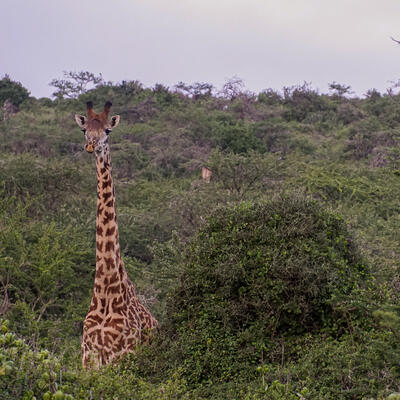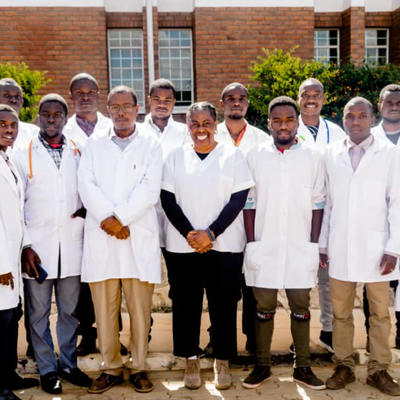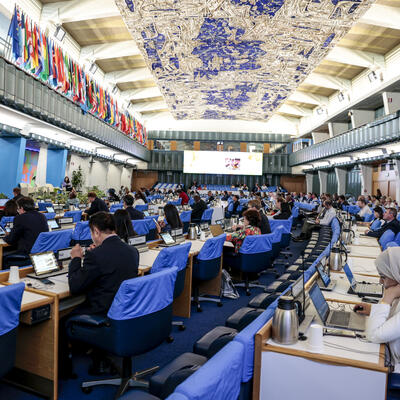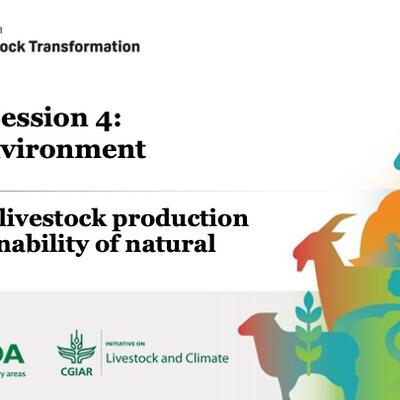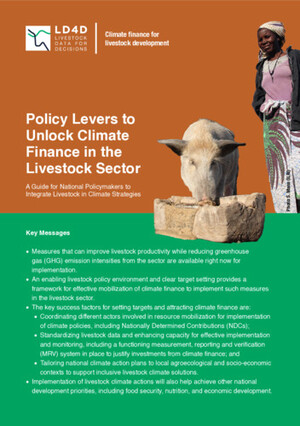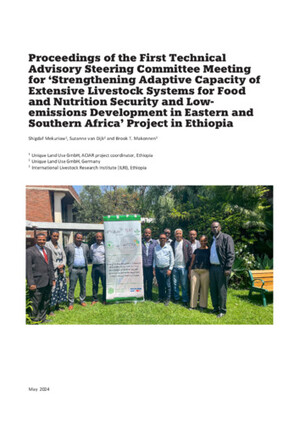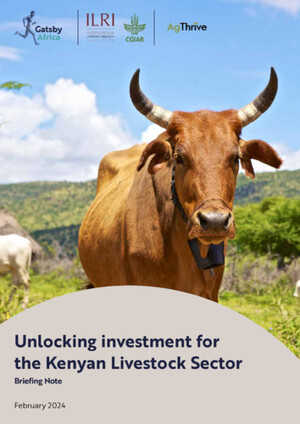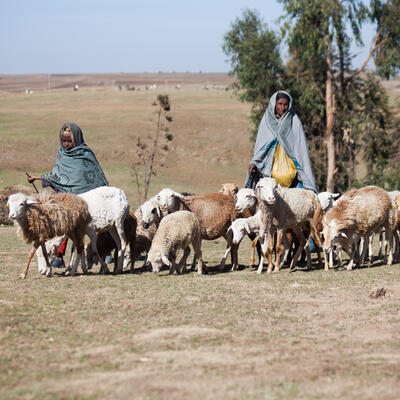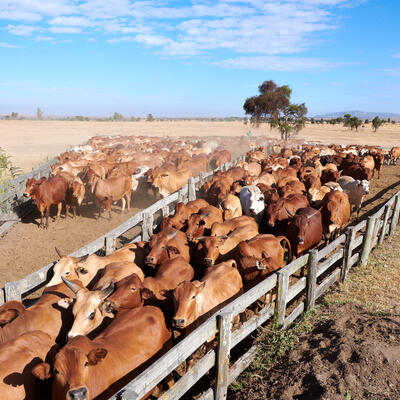
The cow in the room: The roles milk, meat and eggs play in sustainable food systems transformation
Livestock play diverse and integral roles in African food systems, as well as being lifelines for African livelihoods, enabling people to adapt to climate change and possessing great cultural significance across the continent. The livestock perspective is very different in the Global North, where livestock are viewed mainly as a food commodity.
These roles of African livestock were discussed at a recent high-level event at the African Green Revolution Forum (AGRF) in Rwanda on 10 September 2022. The AGRF is an annual conference that brings together all stakeholders in African agriculture. This was the first major livestock event ever held at the AGRF. A diverse panel of experts explored some of the challenging issues around meat, milk and eggs in sustainable food systems as well as solutions to those problems and how to scale them.
Iain Wright, Deputy director general for integrated sciences at the CGIAR’s International Livestock Research Institute (ILRI), opened the session by highlighting that while livestock are playing a key role in African food systems transformation, ‘we need to balance the benefits and harms of livestock and discuss these trade-offs openly. Global discussions around livestock tend to be dominated by voices from the Global North, so it is important that we ensure that perspectives from the Global South, including Africa, are heard at the top.’

Credit: ILRI/Michael Victor,
There are potential synergies in solutions that increase livestock productivity, mitigate livestock greenhouse gas emissions, and provide people with more income and food, such as improving livestock health and feeding practices. For example, it is estimated that adoption of improved livestock practices by smallholder dairy farmers in five East African countries could reduce their absolute carbon equivalent emissions by between 8% and 16% by 2030 while at the same time increasing milk yields by 60% and creating many thousands of new jobs. But there are also areas where hard trade-offs will have to be made between, say, a farmer reducing the number of animals they keep to mitigate emissions or increasing the number to increase household incomes and related livelihood benefits. That said, reduction of animals has to go along with all the other elements of increasing productivity but also addressing other livelihood dimensions through social solutions.
Wright noted the current debates around livestock. ‘Today, the elephant in the room is the cow. Discussions about cows, and livestock more generally, are becoming increasingly “difficult” as some people are now advocating that people stop consuming meat, milk and eggs.’
This session was centred around five questions. Four short videos were shown to illustrate the multiple development goals that can be achieved with livestock, including strengthening the ability of smallholder systems to cope with climate shocks, transforming gender norms to enhance gender equality, improving people’s nutritional outcomes and improving livelihoods (see below for links to all the video shorts). The showing of the videos was followed by a lively panel discussion.
The summary below highlights key points made in responding to the event’s five main questions.
How can livestock production systems positively contribute to food systems transformation in Africa and avoid unsustainable livestock practices seen in other parts of the world?
All panelists highlighted the multi-functional roles livestock play in sustainable development in Africa. It is important, they said, to see all the benefits livestock bring, because in the North, many people see only the problems they can bring.
In Africa, people see livestock as lifelines to education, women’s empowerment and resilience to climate change.
John Ellenberger, senior vice president of Land O’Lakes Venture37, added, ‘Livestock have a role in the development sector and in sustainability issues because livestock create significant positive outcomes for people, the planet and profit.’ The Venture37 case on ‘Dairy nourishes Africa’, highlighted the unassailable benefits of cow milk for children’s health. The discussion that followed noted how animal-source foods—milk, meat, offal, eggs—play key roles in reducing hunger and undernutrition, typically manifest as child stunting, across Africa.
Gbola Adesogan, director of the Food Systems Institute and the Feed the Future Innovation Lab for Livestock Systems at University of Florida, mentioned that in much of Africa there is still lack of knowledge about what constitutes a healthy diet and most people lack access to nutrient-dense animal-source foods.
Adesogan said, ‘Livestock and animal-source foods have to be more visible in agriculture talks about enriching and diversifying diets. Animal-source foods contain macro- and micro-nutrients that are vital for the children of Africa—for their growth and health—yet most of the interventions made to address malnutrition in Africa neglect animal-source foods. For example, on average, the amount of meat eaten by people in the Congo in a year is three hundred times less than that eaten by Europeans.’
The ‘Community-based breeding’ case study highlighted the need to make use of local animal genetics to ensure that livestock are adapted to local climates. This work ensures that the hardy traits of indigenous livestock are maintained in cross-breeding programs to improve animal productivity and profitability without undermining their genetic diversity and adaptability.
Do smallholder livestock keepers and pastoralists still matter in today’s food systems?
The answer to the question of whether smallholder livestock keepers and herders still matter to food systems was as resounding yes! It is estimated that there are approximately 800 million livestock keepers in Africa, of which about 230 million are women and some 280 million are pastoralists. An ILRI case study on ‘Index-based Livestock Insurance’ stressed that, unknown to many, Africa's pastoralist livestock herders generate more than 75% of the continent’s milk and more than half of its meat, and this despite their current climate-related struggles. Well managed, it was argued that pastoralism remains the most effective form of food production and environmental management in dry and marginal lands.
Emma Naluyima, a highly successful Ugandan veterinarian and farmer working with the One Acre Fund, emphasized the importance of integration of crops, animals and fish, which she practices on her one acre farm commented: ‘We are all a product of smallholder farming and livestock; we got our educational opportunities from our parents selling livestock. From a farmer’s perspective, households can turn livestock manure into biogas for cooking and lighting up homes and for fertilizing croplands.’
Livestock provide further benefits to farmers, including income, animal power for draught and transport, social security, and insurance in times of need. At least half of the staple cereals underpinning food security in Africa, it was said, can be produced only because livestock are integral to the cropping system—providing income, animal power and manure.
What policies, financing, and institutional realignments are needed to unlock livestock’s potential to contribute to food systems transformation in Africa?
As Africa's demand for meat and milk grows, so must its livestock sector, which contributes significant amounts of the agricultural GDP of African countries. Currently, the sector contributes an average of 40%of the total agricultural GDP across low- and middle-income countries, ranging between 15% and 80% in individual countries, and this percentage is growing. Unfortunately, as Wright noted, of the USD129 billion in global official development assistance provided in 2020, only 4.3% was funneled into agriculture, and of that small amount for agriculture, just 1.3% went to the livestock subsector.

Credit: ILRI/Michael Victor,Caption
In pastoral areas, targeted financial investments and market interventions help livestock herders to increase their income and to cope with climate stress. While such livestock investments need to increase, there is also need for more specific policies in sustainable livestock development. Juliana Kantengwa, a former member of parliament in Rwanda and a founder of Wood Valley Organics, highlighted the importance of ‘pro-livestock policies’ that can bring multiple benefits. ‘If we want to advance dairy development, we also need to invest in feeder roads, in training and in other services that are needed to make dairy viable.’ She told of how current land use policies in Rwanda do not allow for structures to be built on agricultural lands. The rationale was to prevent unsustainable land conversion, but an unintended consequence has been that it made it obligatory to first obtain a construction permit to put up livestock sheds and barns, which may involve protracted procedures.
Still other livestock areas require investments. Adesogan mentioned that feed is the biggest cost in livestock keeping. Feed is also the biggest determinant of how much greenhouse gases livestock emit, and so deserves much more attention. Wright mentioned the need for better data and evidence. For instance, there are few institutes able to monitor greenhouse gases in Africa. Most data on livestock-generated greenhouse gas emissions have come from the North and have given an inaccurate picture of the emissions from African livestock. Outside of South Africa, ILRI provides robust data on greenhouse gas emissions contextualized for African situations to enable countries to better incorporate livestock aspects into their nationally determined contributions (NDCs) and source climate financing for mitigation and adaptation options.
How can social norms be re-imagined to create greater opportunities for women through livestock interventions?
It is estimated that more than 230 million women across Africa work in the livestock sector—from livestock farming to input supplies to livestock and livestock-related trading and marketing. Livestock are often one of the few assets that women can own and manage on their own. A focus on women and youth, it was said, is absolutely vital for propelling Africa's livestock sector forward.
Elizabeth Swai, CEO and founder of AKM Glitters Company Limited, in Tanzania, shared her experiences in setting up an integrated poultry business that helps disenfranchised women and youth to set up small poultry selling enterprises, including mobile businesses. She emphasized the need for an integrated approach to entrepreneurship including enabling policies and financial support. Capacity building and mentoring small-scale entrepreneurs is critical for business sustainability.
The case study from CARE and ILRI highlighted how veterinary services are an entry point for empowering women in Ghana, where their joint project is encouraging women to serve as veterinarians. Succeeding in this requires a change in that country’s gender norms, because women in Ghana have not traditionally provided animal health care.
Kantengwa also highlighted the importance of gender in policies: ‘Livestock policies, like other policies, are not gender neutral. We need to use specific language to make agriculture and livestock policies gender inclusive.’
Participants mentioned that traditional gender norms run deep in a community-based small ruminant breeding project in Ethiopia. To maximize women’s engagement there, the project has established women-only goat or sheep breeding finance programs, which have markedly improved the women’s access to technical and managerial skills, and agricultural inputs and services.
Moving forward
Wright concluded the session by saying: ‘For transformation to occur, we need to have a nuanced discussion about “the cow in the room”. We need to recognize that the cow in the room looks very different depending on where it is in the world. The cow in Kansas is not the same as the cow in Kenya. The cow in the Netherlands is not the same as the cow in Nigeria. And the cow in my home country, Scotland, is not the same as the cow in Somalia. The answer to our challenges is not to ignore the livestock sector but rather to invest in more sustainable livestock systems and to face the hard trade-offs in livestock issues directly.’

Credit: ILRI/Michael Victor,
Summarizing the event at its close, Simplice Nouala, head of the agriculture and food security division at the African Union Commission, said, ‘We thank AGRF for letting the cow in the room today. It is incredible that we have been discussing Africa’s agricultural transformation without discussing the role of livestock. Let’s make sure that we continue this discussion and let’s be frank about the challenges as well as strengths of the livestock sector. Because we will not achieve food and nutritional security on the African continent without livestock foods—milk, meat and eggs.’







